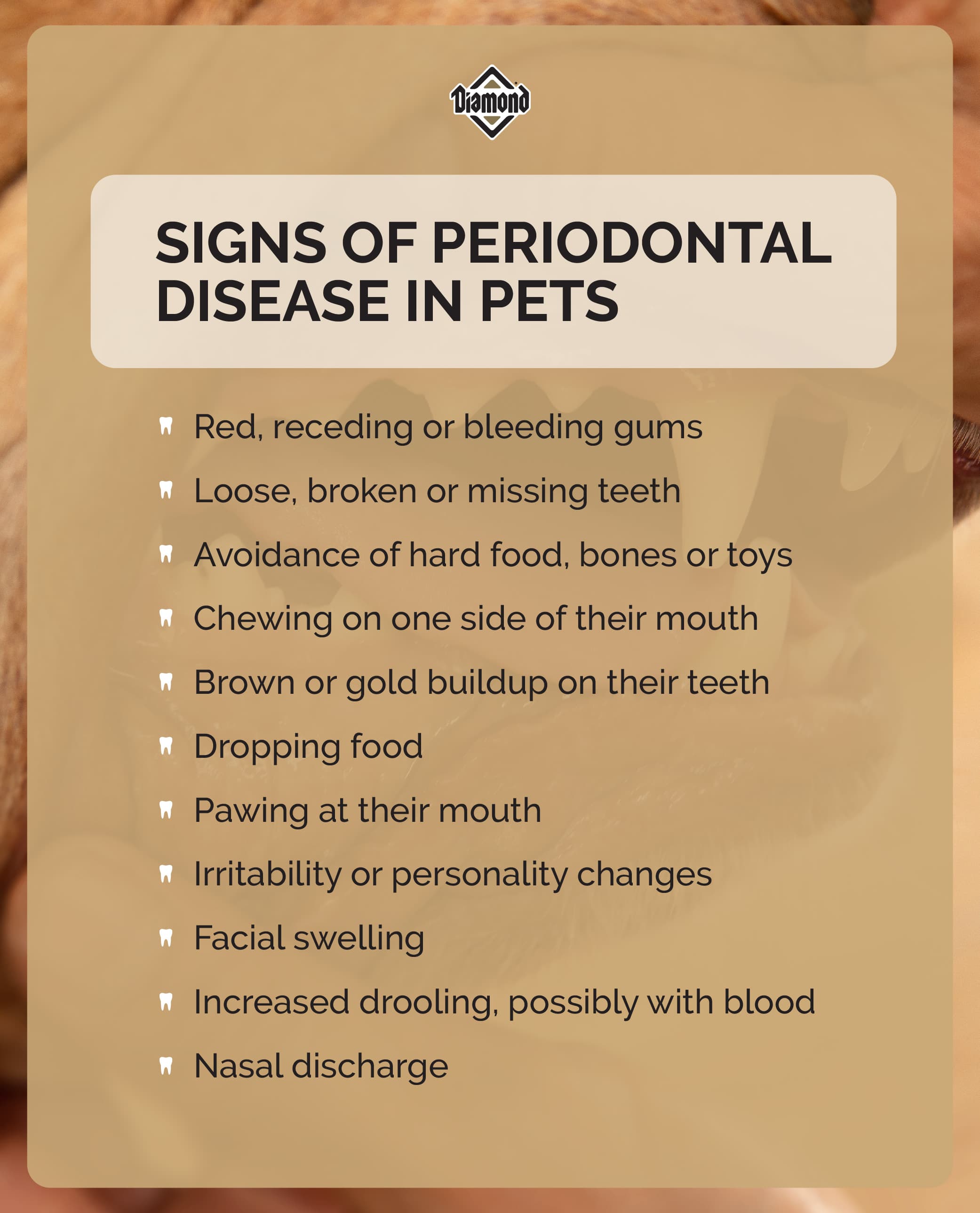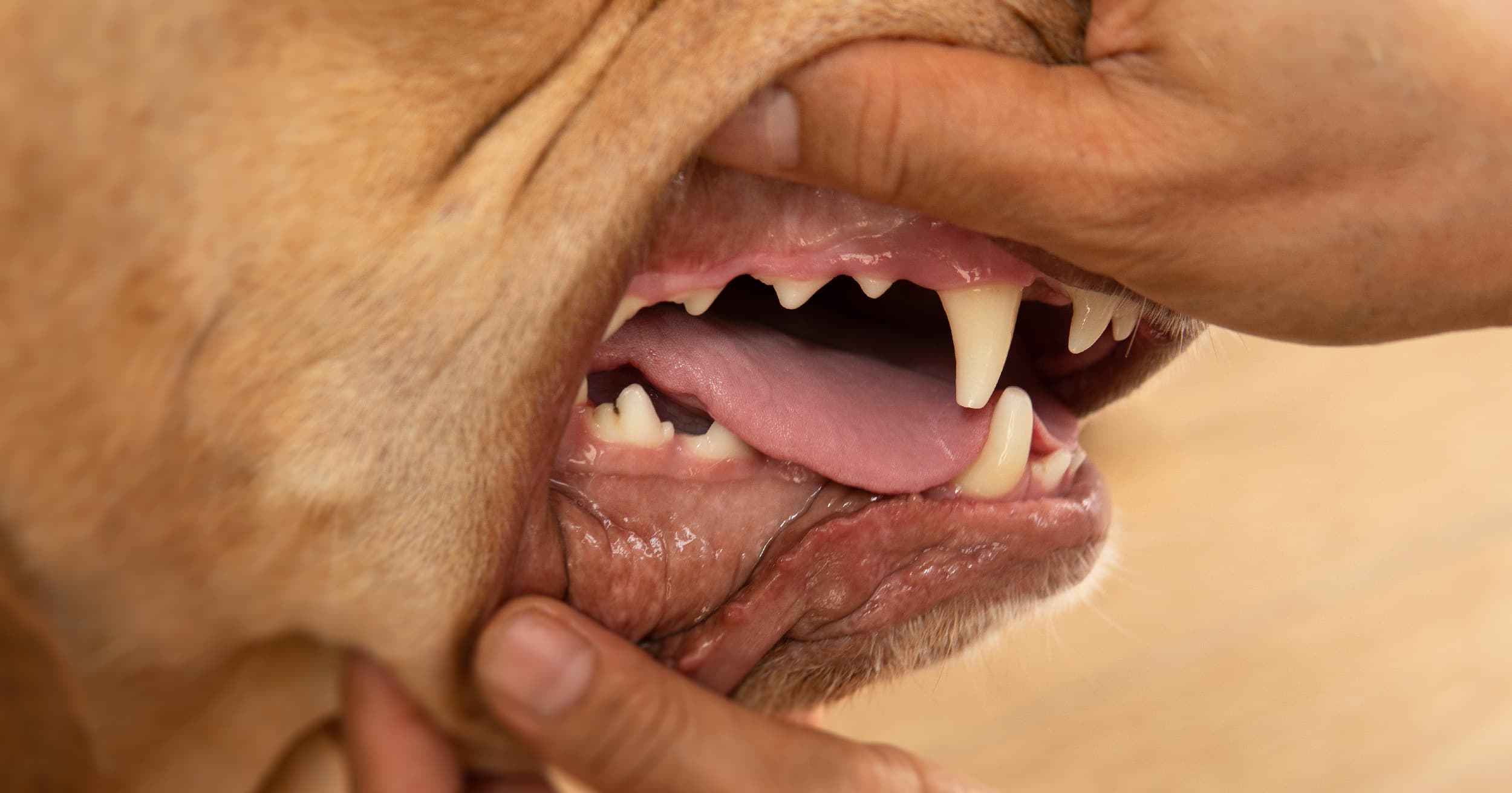Dental care is important for cats and dogs to ensure their teeth and gums remain healthy, just as it is in people. According to the American Veterinary Medical Association, periodontal (gum) disease is the most common oral problem veterinarians see in dogs and cats, with most pets having some degree of periodontal disease by the time they’re three years of age.
The good news is that periodontal disease is preventable by caring for your pet’s teeth and gums at home and by having their teeth professionally cleaned by a veterinarian at regular intervals. To help you learn more about periodontal disease, we’ve listed the signs to look out for and what you can do to help prevent it.
What Is Periodontal Disease?
Periodontal disease is inflammation and infection of the gums and tissues surrounding your pet’s teeth — “periodontal” literally means “around the tooth.” Periodontal disease starts with bacteria forming a sticky biofilm called dental plaque. If the plaque is not removed within 24 hours, minerals in saliva can combine with the plaque and begin to harden into tartar. Plaque can be removed easily with a toothbrush, but tartar requires special dental instruments to remove (i.e., a trip to the veterinary clinic).
The buildup of plaque and tartar can lead to bacteria invading under the gumline, causing painful inflammation, gum recession, bone loss or tooth loss. In some cases the bacteria can also cause unnatural holes between the roof of the mouth and nasal cavity, or broken jaws. Periodontal disease can also allow bacteria to enter your pet’s bloodstream where they can infect and damage other organs, including the heart, kidneys and liver.
Smelly Breath Is a Common Sign
The scary fact about periodontal disease is that because about two-thirds of the tooth is below the gumline, damage can occur without you noticing there’s a problem. Even the early stages above the gumline can be hard to see. But there are signs that your pet may have periodontal disease, with the most common sign being pretty noticeable — stinky breath.
If your pet leans in close for a cuddle and your reflex is to pull away from the stench emanating from their mouth, it’s time for a checkup. While it is a common sign of periodontal disease, chronic bad breath can also be a sign of other medical conditions. So whatever the potential cause, if your pet has constant bad breath, you should have them examined by your veterinarian.
Other signs of periodontal disease include red or bleeding gums, loose teeth, reluctance to chew hard items, a sore or sensitive mouth, personality changes and grooming less often. Cats are especially good at hiding pain and may continue to behave and eat normally, particularly if they swallow their dry kibble whole. But you may still notice some of the signs below in cats as well as dogs.

Regular Brushing Is the Best Prevention Method
The most effective method for preventing or slowing the advancement of periodontal disease is daily brushing. This helps to remove plaque before it can harden into tartar, reducing tartar buildup. Make sure to only use a pet-approved toothpaste because human toothpaste contains fluoride and some contain xylitol, which are both toxic to pets and life threatening if your pet consumes too much of them. The toothbrush can be one that fits on your finger, a child’s toothbrush or a square of gauze wrapped around your finger.
To get your pet used to the taste of their toothpaste, start by letting them lick a small amount from your finger. They should like the taste since pet toothpaste comes in pet-approved flavors like seafood, poultry or peanut. Then introduce them to their toothbrush by letting them lick the toothpaste from it. For the first few times, gently rub the brush under your pet’s chin and gradually work up to touching their lips and rubbing along their gums. Once they’re used to the brush, place the toothbrush in their mouth and focus on brushing the outside surfaces. It may take one to two months of training before you can successfully brush your pet’s teeth. Lot’s of praise and patience are essential, and it helps if you start brushing their teeth when they’re a puppy or kitten.
A Professional Is Needed to Remove Tartar
Daily brushing can help remove plaque, but a professional teeth cleaning performed by your veterinarian or a board-certified veterinary dentist is necessary to remove the tartar that’s above and below the gum line. A cleaning at the veterinary clinic will typically include ultrasonic and hand scaling to remove tartar and plaque, probing around the teeth and gums to look for issues, polishing the smooth teeth surfaces and possibly taking X-rays of your pet’s mouth to check for hidden abscesses and bone loss. If this sounds familiar, you’re right — it’s just like when you go to the dentist for a professional cleaning and checkup.
It’s recommended that you don’t use hard treats or toys (e.g., bones, horse hoofs, antlers, hard nylon toys) to help clean your pet’s teeth as they can break their teeth, or shatter and be swallowed leading to gastrointestinal tract blockage or damage. Toys or treats that bend or have some give are better choices. The American Animal Hospital Association has a graphic showing common products that may cause problems for your pet. The Veterinary Oral Health Council (VOHC) has a list of VOHC-approved foods, chew treats, toothbrushes, toothpastes, dental wipes and water additives that have been proven to help reduce plaque and tartar on your pet’s teeth.
Treating Periodontal Disease
Routine examinations of your pet’s mouth (e.g., at their annual checkup) are important for early diagnosis and treatment of periodontal disease. Your veterinarian may need to take an X-ray of your pet’s mouth to find problems below the gum line, like a tooth root abscess or tooth resorption that can occur in cats. They will make recommendations to treat any dental issues as well as any related health conditions. If you would like to learn more, the American Veterinary Dental College has informative pictures and information about the five stages of periodontal disease and the typical treatments required for each stage.
Regularly brushing your pet’s teeth may not seem like a fun task (for either of you), but it is important to keep your pet’s teeth and gums healthy and prevent dental issues like periodontal disease. Plus, it may help prevent stinky pet breath, which makes snuggle time a lot more enjoyable.
RELATED POST: Debarking Pet Myths: A Dog’s Mouth Is Cleaner Than a Human’s







